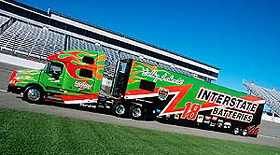When When Not To Log
Topic 18210 | Page 2

Keep going, guys. I ran out of popcorn. You learn SO MUCH here...
May need several dozen bags of Orville's finest movie theater butter microwave popcorn for this one!

The main question here, to me, is how to account for time spent at job #1. I totally agree with Rick that the best course of action would be to discuss this with the safety guy at job #2 to verify On Duty/Not Driving as the appropiate way to account for your time at job #1, as they would be the ones that would need to CYA. I was in a similar situation for a while. I worked a non-CDL job and drove motorcoach part-time. G-Town hit it with the "Time Worked Statement" being required with new and/or intermittent drivers, but I drove on a somewhat regular basis (worked non CDL job 4 days on - 4 days off and drove in between) and handled it a bit differently. We used paper logs when I first started driving, and logged every day whether it was the driving or non-driving job. Later when switching to e-logs, I had the ability to add "on duty" entries from my non-driving job by home computer ( which made life a whole lot easier). This accounted for ALL my time worked to satisfy logging requirements of the bus company. Another suggestion to the OP is that since you have to keep logs for job #2, (you said that they told you that you had to "log in") is to track your worked hours on a calendar to see what kind of hours you available to commit to driving bus. Since you currently don't keep logs and have to worry about your available hours, I believe that you may be surprised how quickly you run into the 70hr/8 days HOS wall and not be able to drive bus that much.
CDL:
Commercial Driver's License (CDL)
A CDL is required to drive any of the following vehicles:
- Any combination of vehicles with a gross combined weight rating (GCWR) of 26,001 or more pounds, providing the gross vehicle weight rating (GVWR) of the vehicle being towed is in excess of 10,000 pounds.
- Any single vehicle with a GVWR of 26,001 or more pounds, or any such vehicle towing another not in excess of 10,000 pounds.
- Any vehicle, regardless of size, designed to transport 16 or more persons, including the driver.
- Any vehicle required by federal regulations to be placarded while transporting hazardous materials.
HOS:
Hours Of Service
HOS refers to the logbook hours of service regulations.
Bob H suggests:
Later when switching to e-logs, I had the ability to add "on duty" entries from my non-driving job by home computer ( which made life a whole lot easier). This accounted for ALL my time worked to satisfy logging requirements of the bus company.
Hey Bob. Yes, that makes sense. The elapsed time is key though, less than 7 days. Since the gap in your driving was only four days, the previous 4 days were active in your e-log record. In effect you were complying by recording your time while not driving, working at your other company. Not every company has the capability you described. Also the time worked statement requires a witness (company driver manager or dispatcher) to counter sign the document.
I honestly think the OP needs to inquire with the bus company on what is required to comply.
Dispatcher:
Dispatcher, Fleet Manager, Driver Manager
The primary person a driver communicates with at his/her company. A dispatcher can play many roles, depending on the company's structure. Dispatchers may assign freight, file requests for home time, relay messages between the driver and management, inform customer service of any delays, change appointment times, and report information to the load planners.Driver Manager:
Dispatcher, Fleet Manager, Driver Manager
The primary person a driver communicates with at his/her company. A dispatcher can play many roles, depending on the company's structure. Dispatchers may assign freight, file requests for home time, relay messages between the driver and management, inform customer service of any delays, change appointment times, and report information to the load planners.New Reply:
New! Check out our help videos for a better understanding of our forum features

















Preview:








 TT On Facebook
TT On Facebook
It isn't me who is taking the "contentious tone" and making snide remarks. This part of your post is a perfect example (in addition to your prior responses). There is nothing factually wrong in my posts, so instead you attack me personally, eg., "(despite your obvious research skills), I gotta take your responses with a grain of salt" and "anyone can copy and paste regs." It doesn't matter if the poster is a one-day newbie or a fifty-year veteran, if the post is factual then it stands on its own. If it isn't, then by all means, post the correct information.
And, since you asked; over 33 years of Class 1 possession AND use, most of the lower 48, seven of ten Canadian provinces and two territories, from the Mexican border at Brownsville, TX, to the Arctic Ocean at Tuktoyaktuk, NT, highways, byways, off-road, winter roads, ice roads, dry van , reefer , flat, step, RGN, tanker (including pressurized), multi-trailer, OS/OW up to 160,000 lbs, 160 ft long, 20 ft wide, 20 ft tall, 11-axle, winch truck, bed truck, crane truck, hazardous goods such as fuels, chemicals, cryogenic, loads in excess of $5,000,000, owned and managed fleet specializing in oilfield and heavy-haul, executive responsible for compliance, industry consultant, etc. How about you?
Note the highlighted portion. You are right, it isn't even debatable; FMCSA regulations apply ONLY to interstate commerce. If neither the carrier, nor the freight, are interstate, then the applicable state transportation regulations apply (which may, or may not, be the same as the federal regulations). Therefore, if the subject is intrastate only, 49 CFR DOES NOT APPLY. However I am assuming the OP is subject to the FMCSA regulations given the forum, but his post raises the question of whether or not he is.
As for the rest, you are making things up. NOWHERE did I suggest the OP is "in some 'alternate universe'," nor did I suggest that he is not subject to the RELEVANT HOS regulations.
I did post both the reg. AND an explanation; IF Job1 is doing "this", THEN he will be fine doing as Job2 asks.
CSA:
Compliance, Safety, Accountability (CSA)
The CSA is a Federal Motor Carrier Safety Administration (FMCSA) initiative to improve large truck and bus safety and ultimately reduce crashes, injuries, and fatalities that are related to commercial motor vehicle
FMCSA:
Federal Motor Carrier Safety Administration
The FMCSA was established within the Department of Transportation on January 1, 2000. Their primary mission is to prevent commercial motor vehicle-related fatalities and injuries.
What Does The FMCSA Do?
DOT:
Department Of Transportation
A department of the federal executive branch responsible for the national highways and for railroad and airline safety. It also manages Amtrak, the national railroad system, and the Coast Guard.
State and Federal DOT Officers are responsible for commercial vehicle enforcement. "The truck police" you could call them.
CMV:
Commercial Motor Vehicle
A CMV is a vehicle that is used as part of a business, is involved in interstate commerce, and may fit any of these descriptions:
Interstate Commerce:
Commercial trade, business, movement of goods or money, or transportation from one state to another, regulated by the Federal Department Of Transportation (DOT).
Interstate:
Commercial trade, business, movement of goods or money, or transportation from one state to another, regulated by the Federal Department Of Transportation (DOT).
Intrastate:
The act of purchasers and sellers transacting business while keeping all transactions in a single state, without crossing state lines to do so.
Fm:
Dispatcher, Fleet Manager, Driver Manager
The primary person a driver communicates with at his/her company. A dispatcher can play many roles, depending on the company's structure. Dispatchers may assign freight, file requests for home time, relay messages between the driver and management, inform customer service of any delays, change appointment times, and report information to the load planners.Dry Van:
A trailer or truck that that requires no special attention, such as refrigeration, that hauls regular palletted, boxed, or floor-loaded freight. The most common type of trailer in trucking.Reefer:
A refrigerated trailer.
HOS:
Hours Of Service
HOS refers to the logbook hours of service regulations.